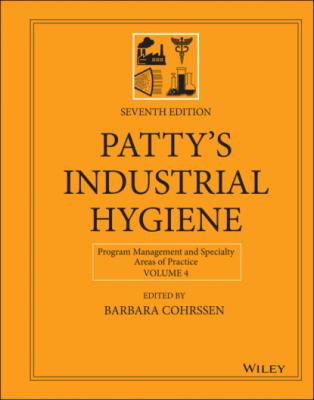Patty's Industrial Hygiene, Program Management and Specialty Areas of Practice. Группа авторов
Читать онлайн.| Название | Patty's Industrial Hygiene, Program Management and Specialty Areas of Practice |
|---|---|
| Автор произведения | Группа авторов |
| Жанр | Химия |
| Серия | |
| Издательство | Химия |
| Год выпуска | 0 |
| isbn | 9781119816249 |
packaging management;
security of products and raw materials from deliberate misuse; and
promotion of Responsible Care by name along the value chain.
3.2 Specific Examples of Company Definitions
Chemical Manufacturing companies of these associations have defined their programs based on the general requirements and in many cases have publicly available documents that define the elements for their business. These companies are working to accomplish the same goal but have different definitions of what PS means to them. Below is a selection of definitions found in public documents.
3.2.1 Sartomer
PS is defined as the management of the safety, health, and environmental (SHE) aspects of a product throughout its life cycle in an ethically responsible way and in line with our SHE policy. Specifically, PS is defined as the responsibility to control and minimize all possible safety risks and adverse effects on human or animal health or on the environment that could be caused by the substances present in products throughout their entire life cycle. An important aspect of PS is compliance driven Product Safety which ensures DSM Chemicals license to sell.
https://www.dsm.com/corporate/sustainability/managing-sustainability/product-stewardship.html
3.2.2 Linde
We systematically identify, assess, and control risks across the entire life cycle of our products – from materials purchasing and manufacturing up to the use of our products by the customer. The basis for this is our global guideline for product responsibility. The implementation of these guidelines is verified through global audits. We have also established specific standards that cover the core areas of PS. These include guidelines on:
The introduction of new products.
The classification and labeling of chemicals and hazardous substances.
The introduction and sale of sensitive chemicals. The production of safety data sheets.
Safety checks carried out with customers.
The management of product liability risks for new products and applications.
The transport of gases.
3.2.3 Brenntag (Chemical Distributor)
Brenntag takes appropriate measures to ensure the proper handling of our products while they are under the Group's stewardship. This includes procurement, packaging, classification and labeling, handling, storage, and safe transportation, as well as the creation of product dossiers and safety instructions as well as disposal, where necessary.
https://www.brenntag.com/canada/en/safety-and-sustainability/safety/product-stewardship/index.jsp
3.2.4 Bayer
We consider PS to mean that our products satisfy the highest quality standards and are safe for people, animals, and the environment when properly used. All substances and finished products undergo extensive testing and evaluation in the interest of product safety. We assess possible health and environmental risks along the entire value chain and implement the appropriate measures to mitigate risks based on this.
We strictly observe the legal requirements, and our voluntary commitment and internal standards go beyond these in many areas. This is steered by the Corporate Health, Safety and Sustainability function, which is responsible for implementing the related policies and maintaining the Health, Safety and Environmental (HSE) management systems.
3.2.5 Monsanto
PS is the responsible development, management, and use of technologies, and products across our seeds, traits, and crop protection businesses throughout the entire product life cycle.
https://monsanto.com/products/product-stewardship
Government agencies have varying degrees of involvement in PS activities and also have defined the term in various ways depending on their focus.
3.2.6 British Columbia
Also known as Extended Producer Responsibility (EPR), this approach to recycling creates efficiencies and raises awareness about producing items that do not harm the environment.
There is actually financial incentive for producers to create better designed products that can be disposed of responsibly. Ultimately, this will reduce municipal waste disposal costs as well as the amount of garbage in landfills.
Industry is more responsible to managing the life cycle of designated products and consumer packaging they create and distribute. Your cooperation is needed for the proper collection and recycling of these types of items.
3.2.7 New Zealand
We all need to help reduce the impacts of manufactured products on our environment. When a producer, brand owner, importer, retailer, or consumer accepts the responsibility for reducing a product's environmental impact, we call this PS.
PS helps us transition from a linear to a circular economy.
http://www.mfe.govt.nz/waste/product-stewardship/about-product-stewardship
Private advocacy groups and institutions have also defined PS based on their activities and emphasis. One example is given below:
3.2.7.1 Product Stewardship Institute
The Product Stewardship Institute – a consumer advocacy group – defines product stewardship as “the act of minimizing the health, safety, environmental, and social impacts of a product and its packaging throughout all life cycle stages, while also maximizing economic benefits.”
3.2.7.2 Product Stewardship Society
This group was formed in 2013 with a focus on professional development through education, publications, and networking. Their definition is:
Responsibly managing the health, safety, and environmental aspects of products throughout their life cycle and across the value chain in order to prevent or minimize negative impacts and maximize value.
In reviewing the abovementioned examples, common elements become quite clear. Whether defined as a set of principles, a program, a tool, a policy, or a process the focus is a product. The risk management of products throughout their life cycle requires an integrated organizational approach, and close relationships with customers and others involved in the supply chain
